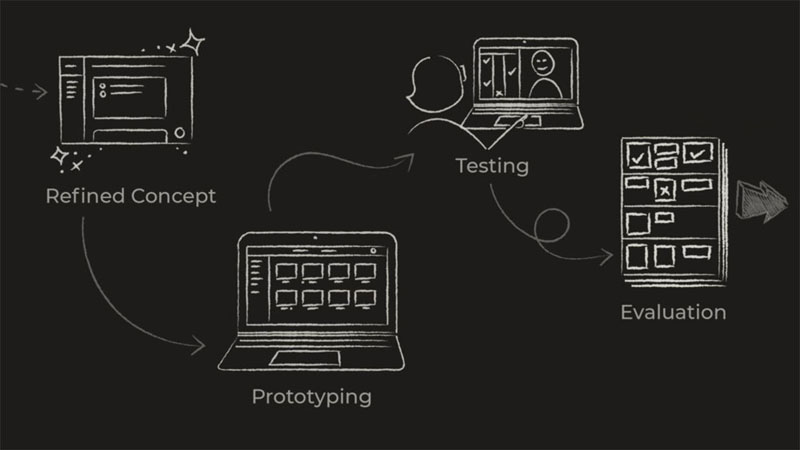References:
Books:
- Ally, Mohamed. 2004. “Foundations of educational theory for online learning.” Theory and practice of online learning 2 (2004): 15-44.
- Cole, Robert A., ed. 2000. “Issues in Web-based pedagogy: A critical primer.” Greenwood Publishing Group.
- Eyal, Nir. 2014. “Hooked: How to build habit-forming products.” Penguin Books.
- Kozma, Robert. 2001. “Robert Kozmas counterpoint theory of learning with media.” Learning from media: Arguments, analysis and evidence (2001): 137-178.
- Schramm, Wilbur Lang. 1977. “Big media, little media.” Sage Publications.
Web:
- Althaus, Scott L. 1997. “Computer-mediated communication in the university classroom: An experiment with online discussions.” (1997): 158-174.
https://nca.tandfonline.com/doi/abs/10.1080/03634529709379088#.Xk4tMBMzZQI
- Ambady, Nalini, and Robert Rosenthal. 1993. “Half a minute: Predicting teacher evaluations from thin slices of nonverbal behavior and physical attractiveness.” Journal of personality and social psychology 64, no. 3 (1993): 431
https://www.drjoebio.com/uploads/1/8/1/3/1813500/30_seconds_teacher_quality.pdf
- Becker, Katrin. 2010. “The Clark-Kozma Debate in the 21-st Century.”
http://mruir.mtroyal.ca/xmlui/handle/11205/143
- Bielman, Virginia A., Leann G. Putney, and Neal Strudler. 2003. “Constructing community in a postsecondary virtual classroom.” Journal of Educational Computing Research 29, no. 1 (2003): 119-144.
https://journals.sagepub.com/doi/abs/10.2190/P84L-R8AK-0XV6-W3VL
- Blackboard Learning Management System. n.d. “Design your course with Blackboard Classroom.” Accessed February, 2020.
https://help.blackboard.com/Blackboard_Open_LMS/Teacher/Design_Your_Course/Blackboard_Classroom
- Blended Learning Models. 2020. Accessed January, 2020.
https://www.blendedlearning.org/models/
- Blignaut, A. Seugnet, and Stanley R. Trollip. 2003. “Measuring faculty participation in asynchronous discussion forums.” Journal of Education for Business 78, no. 6 (2003): 347-353.
https://www.tandfonline.com/doi/abs/10.1080/08832320309598625
- Boettcher, J. V. 2011. “Ten best practices for teaching online: Quick guide for new online faculty.” Designing for Learning (2011).
https://www.academia.edu/1991803/Ten_Best_Practices_for_Teaching_Online
- Clark, Richard E. 1994. “Media will never influence learning.” Educational technology research and development 42, no. 2 (1994): 21-29.
https://link.springer.com/article/10.1007/BF02299088
- Cuthrell, Kristen, and Anna Lyon. 2007. “Instructional strategies: What do online students prefer.” Journal of Online Learning and Teaching 3, no. 4 (2007): 357-362.
https://jolt.merlot.org/documents/cuthrell.pdf
- E-Learning Industry. December 22, 2016. “Strategies for Online Teaching” Accessed February, 2020.
https://elearningindustry.com/5-strategies-improve-your-online-teaching
- GoConqr. n.d. “GoConqr for Educators”. Accessed February, 2020.
https://www.goconqr.com/en/teach/teachers
- IEEE. March 20, 2003. “SCORM Sharable Content Object Reference Model.” Accessed March, 2020.
https://ieeexplore.ieee.org/document/1186122
- KhanAcademy. 2020. “Khan Academy for Teachers.” Accessed February, 2020.
https://www.khanacademy.org/teachers
- Kozma, Robert B. 1991. “Learning with media.” Review of educational research 61, no. 2 (1991): 179-211.
https://journals.sagepub.com/doi/abs/10.3102/00346543061002179
- McIsaac, Marina Stock, J. Michael Blocher, Veena Mahes, and Charalambos Vrasidas. 1999. “Student and teacher perceptions of interaction in online computer-mediated communication.” Education Media International 36, no. 2 (1999): 121-131.
https://www.tandfonline.com/doi/pdf/10.1080/0952398990360206
- Michigan Ross Education Program, University of Michigan. n.d. “Blended and online learning.” Accessed January, 2020.
https://michiganross.umich.edu/programs/executive-education/why-ross/blended-learning
- Mikulecky, Larry. 1998. “Diversity, discussion, and participation: Comparing web-based and campus-based adolescent literature classes.” Journal of Adolescent & Adult Literacy 42, no. 2 (1998): 84-97.
https://www.jstor.org/stable/40016791?seq=1#metadata_info_tab_contents
- Moore, Joi L., Camille Dickson-Deane, and Krista Galyen. 2011. “e-Learning, online learning, and distance learning environments: Are they the same?.” The Internet and Higher Education 14, no. 2 (2011): 129-135.
https://www.sciencedirect.com/science/article/abs/pii/S1096751610000886
- Presentation Point. September 30, 2015. “Migrating from Powerpoint.” Accessed April, 2020.
https://www.presentationpoint.com/blog/best-powerpoint-screen-resolution/
- Slido. January 23, 2020. “Classroom Interaction Through Live Polls” Accessed April, 2020.
https://blog.sli.do/classroom-interaction-live-polls/
- Tallent-Runnels, Mary K., Julie A. Thomas, William Y. Lan, Sandi Cooper, Terence C. Ahern, Shana M. Shaw, and Xiaoming Liu. 2006. “Teaching courses online: A review of the research.” Review of educational research 76, no. 1 (2006): 93-135.
https://www.researchgate.net/publication/220017745_Teaching_Courses_Online_A_Review_of_the_Research
- Teach Thought. June 18, 2019. “Types of Blended Learning”. Accessed January, 2020.
https://www.teachthought.com/learning/12-types-of-blended-learning/
- Twigg, Carol A. 2003. “Models for online learning.” Educause review 38 (2003): 28-38.
https://blendedtoolkit.wisc.edu/wp-content/uploads/2014/04/twigg.pdf
- Unlock It. October 22, 2002. “Entelechy Designing Training Based on Five Content Types.” Accessed April, 2020.
https://www.unlockit.com/wp-content/uploads/five_content_types.pdf
- Usip, Ebenge E., and Richard H. Bee. 1998. “Economics: A discriminant analysis of students’ perceptions of web-based learning.” Social Science Computer Review 16, no. 1 (1998): 16-29.
https://journals.sagepub.com/doi/abs/10.1177/089443939801600104
- Wilson, Tina, and Denise Whitelock. 1998. “Monitoring the online behaviour of distance learning students.” Journal of computer assisted learning 14, no. 2 (1998): 91-99.
https://onlinelibrary.wiley.com/doi/abs/10.1046/j.1365-2729.1998.1420091.x
Other Links:
Case Study Download:
• BodhiTree 2.0......




